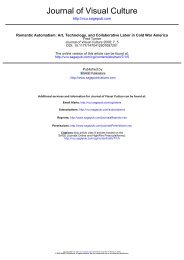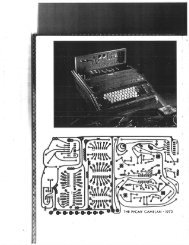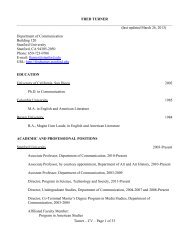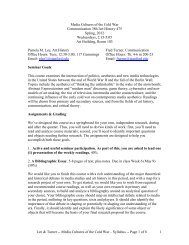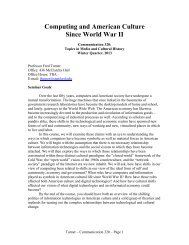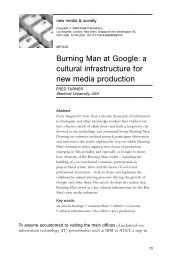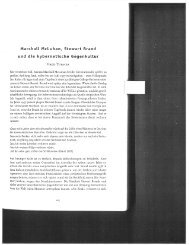The Family of Man and the Politics of Attention in ... - Public Culture
The Family of Man and the Politics of Attention in ... - Public Culture
The Family of Man and the Politics of Attention in ... - Public Culture
Create successful ePaper yourself
Turn your PDF publications into a flip-book with our unique Google optimized e-Paper software.
<strong>Public</strong> <strong>Culture</strong><br />
ican policies, <strong>and</strong> developed an armed services program to support soldiers <strong>in</strong> <strong>the</strong><br />
field <strong>and</strong> veterans at home.<br />
Of all <strong>the</strong> work <strong>the</strong>y undertook, museum <strong>of</strong>ficials were perhaps proudest <strong>of</strong> a<br />
s<strong>in</strong>gle exhibition, <strong>the</strong> 1942 propag<strong>and</strong>a blockbuster Road to Victory. <strong>The</strong> exhibition<br />
“was not only a masterpiece <strong>of</strong> photographic art but one <strong>of</strong> <strong>the</strong> most mov<strong>in</strong>g<br />
<strong>and</strong> <strong>in</strong>spir<strong>in</strong>g exhibitions ever held <strong>in</strong> <strong>the</strong> museum,” <strong>the</strong>y recalled at a meet<strong>in</strong>g<br />
three years later. 21 It was also <strong>the</strong> place at which Steichen first mastered <strong>the</strong> aes<strong>the</strong>tic<br />
strategies that he would later employ <strong>in</strong> <strong>The</strong> <strong>Family</strong> <strong>of</strong> <strong>Man</strong>. In <strong>the</strong> fall <strong>of</strong><br />
1941, at <strong>the</strong> request <strong>of</strong> museum trustee David McAlp<strong>in</strong>, Steichen began troll<strong>in</strong>g<br />
through thous<strong>and</strong>s <strong>of</strong> photographs, almost all from government collections. Of <strong>the</strong><br />
150 images that Steichen eventually chose, more than 130 came from <strong>the</strong> FSA. 22<br />
<strong>The</strong> rest came from <strong>the</strong> army <strong>and</strong> navy, various press agencies, <strong>and</strong> several o<strong>the</strong>r<br />
government bureaus. Like Steichen’s own work at <strong>the</strong> time, <strong>the</strong> images tended<br />
to be “straight” photography — that is, <strong>the</strong>y depicted <strong>the</strong>ir subjects mostly <strong>in</strong> a<br />
head- on, straightforward manner, with clear, sharp l<strong>in</strong>es <strong>and</strong> a strong documentary<br />
flavor. Steichen also recruited S<strong>and</strong>burg to create a text for <strong>the</strong> show. F<strong>in</strong>ally,<br />
<strong>in</strong> what turned out to be an <strong>in</strong>spired decision, <strong>the</strong> Museum <strong>of</strong> Modern Art’s director<br />
<strong>of</strong> exhibitions, Monroe Wheeler, paired <strong>the</strong>se two middlebrow American realists<br />
with a representative <strong>of</strong> <strong>the</strong> European avant- garde, Bauhaus refugee designer<br />
Herbert Bayer.<br />
Before emigrat<strong>in</strong>g to <strong>the</strong> United States <strong>in</strong> 1938, Bayer had labored <strong>in</strong> <strong>the</strong><br />
German Bauhaus as a student <strong>and</strong> <strong>the</strong>n an <strong>in</strong>structor <strong>of</strong> design. He became best<br />
known for his work <strong>in</strong> typography, <strong>in</strong>clud<strong>in</strong>g his development <strong>of</strong> <strong>the</strong> all- lowercase<br />
typeface used <strong>in</strong> many Bauhaus publications. After leav<strong>in</strong>g <strong>the</strong> Bauhaus <strong>in</strong> 1928,<br />
Bayer also worked as an exhibition designer. In 1930 he <strong>and</strong> former Bauhaus colleagues<br />
Walter Gropius <strong>and</strong> László Moholy- Nagy designed <strong>the</strong> German contribution<br />
to <strong>the</strong> Exposition de la Société des artistes décorateurs at <strong>the</strong> Gr<strong>and</strong> Palais <strong>in</strong><br />
Paris. 23 Bayer was responsible for a display <strong>of</strong> mass- produced everyday objects.<br />
Conventional exhibition practice <strong>of</strong> <strong>the</strong> time suggested that Bayer should arrange<br />
his objects <strong>and</strong> images ei<strong>the</strong>r at eye level or as <strong>the</strong>y might be seen <strong>in</strong> an actual<br />
21. “<strong>The</strong> M<strong>in</strong>utes <strong>of</strong> <strong>the</strong> Sixteenth Annual Meet<strong>in</strong>g <strong>of</strong> <strong>the</strong> Board <strong>of</strong> Trustees <strong>and</strong> Members <strong>of</strong> <strong>the</strong><br />
Corporation <strong>of</strong> <strong>the</strong> Museum <strong>of</strong> Modern Art Held on Thursday, November 15, 1945,” <strong>in</strong> Bullet<strong>in</strong> <strong>of</strong> <strong>the</strong><br />
Museum <strong>of</strong> Modern Art, February 1946, 5.<br />
22. Maren Stange, Symbols <strong>of</strong> Ideal Life: Social Documentary Photography <strong>in</strong> America,<br />
1890 – 1950 (Cambridge: Cambridge University Press, 1989), 135.<br />
23. Paul Overy, “Visions <strong>of</strong> <strong>the</strong> Future <strong>and</strong> <strong>the</strong> Immediate Past: <strong>The</strong> Werkbund Exhibition, Paris<br />
1930,” Journal <strong>of</strong> Design History 17, no. 4 (2004): 337 – 57; Staniszewski, Power <strong>of</strong> Display, 25 – 27.<br />
66



